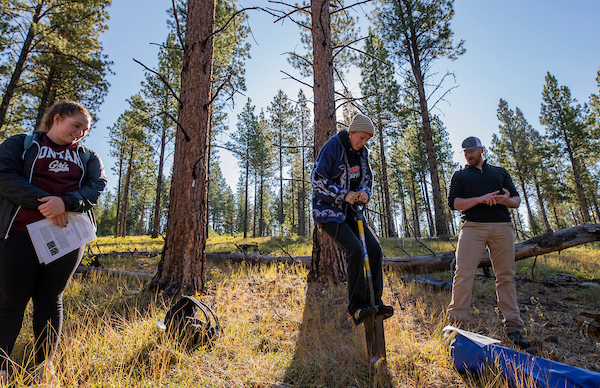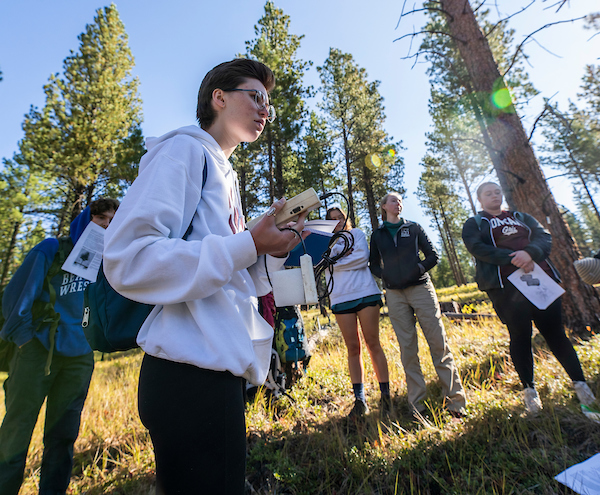UM Students Flock to New Environmental Science Major
MISSOULA – Earlier this fall, a group of University of Montana students majoring in Environmental Science and Sustainability spent the weekend at UM’s Lubrecht Experimental Forest, learning about the environment and conservation in western Montana.
Their thirst for knowledge about topics like restoration, climate and water reflects a growing interest among students on employing environmental science to promote sustainability – an interest that has made ESS one of UM’s fastest growing new majors.
“I think students are really excited about connecting science – especially environmental science – and sustainability,” said Laurie Yung, professor and ESS program director. “They want the scientific foundation, but they also want the skills to make change in the world.”

Housed in the W.A. Franke College of Forestry and Conservation, ESS started out with 15 students in 2020 and one year later has 115 students – 88 of whom are new to the major and 68 of whom are new to UM this semester.
The field course at Lubrecht is one of the first classes ESS majors take. Students participated in discussions about public land policy and the history of the region, including Native American perspectives. They met with representatives from local land management agencies and community partners like the U.S. Forest Service, the Blackfoot Challenge and Montana Fish, Wildlife & Parks. They also completed a service project with the Blackfoot Challenge, pulling weeds, tearing down old fencing and building a nature trail at the Blackfoot Community Conservation Area.
“The vison for the course is to get ESS students out into western Montana to reinforce that their classroom in bigger than the walls of UM,” said course instructor Brian Chaffin, associate professor of water policy and governance. “We want students to get a sense of current challenges on the landscape and introduce them to University partners who are in the field working on these problems right now.”

A UM student holds a tool that measures the water content of soil.
Lark Olson, a UM first-year student from Kalispell, chose ESS as a major after developing an interest in environmental issues while taking a two-year environmental systems and society course through her high school’s International Baccalaureate program.
Olson said she particularly enjoyed the weekend’s trip to the Blackfoot River, where she collected and sorted aquatic invertebrates to sample the river’s water quality.
“All in all, though, my favorite part of the seminar was all of the amazing people that I got to meet,” said Olson who is double majoring in music and plays for the UM Symphony Orchestra. “I’ve never been around so many people who share my interests., It was a great way to get the ball rolling in terms of learning about what I may want to do in the environmental science field.”
The interdisciplinary nature of the ESS program is a draw for students, Yung said. They receive a broad education in environmental science and can specialize in six concentrations, including the highly flexible resource conservation concentration. The major requires hands-on learning, so students walk away with real-world experience.
“Our students want a science degree that is very integrated, and they want to learn how to use that science to solve problems,” Yung said. “The ESS degree connects science to action. UM is a beautiful, amazing place. You can go right out the door into western Montana and get hands-on experience with the very topics you are studying. You’re not only learning how ecological and social systems work on the ground but also meeting the leaders who are solving environmental problems.”
UM junior Brooke DeRuwe originally chose a different focus in the college, but immediately switched majors as soon as she heard about the new ESS program.
“I think that the degree is giving me a well-rounded education in environmental science,” she said. “It’s a broad major that you can focus on something specific. Especially for students who don’t want to declare a specific path. If you’re interested in nature at all, majoring in environmental science will open so many doors for you.”
Originally from Spokane, Washington, DeRuwe is minoring in climate change studies and is a part of the Franke Global Leadership Initiative. She’s also a UM Advocate and a member of the Climate Response Club. She wants to eventually work with the ocean and study marine science.
“People just chuckle because there is no ocean in Montana,” she said. “I’m well aware of that.”
Last summer DeRuwe worked as an intern at the Mote Marine Laboratory and Aquarium in Sarasota, Florida, helping with data collection and research for its sea turtle program. Duties included releasing baby sea turtles back into the wild.
The internship provided important work experience and fulfilled DeRuwe’s experiential learning requirement. She says her experiences in the ESS major and the College of Forestry and Conservation helped her land the internship.
“I want prospective students to know that they’re going to be supported by faculty and fellow students,” DeRuwe said. “It’s a very welcoming community. If there’s anything you want to achieve, the people around you are going to help make that happen to the best of their ability.”
Chaffin said the ESS program encapsulates the best of what the Franke College of Forestry and Conservation has to offer.
“Students who know they want to work in the environmental field, but they’re not sure they want to be something very specific like a forester or a wildlife biologist, can explore every aspect of human-environment relationships,” he said. “They can take classes in fire simultaneously with classes in rural community development. They can sample everything and also get a strong foundation in environmental sciences. There’s no limit in the environmental space to where students can work with this degree.”
###
Contact: Laurie Yung, Environmental Science and Sustainability program director, 406-243-6934, laurie.yung@mso.umt.edu.